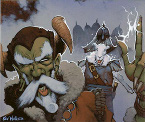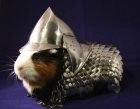JeffroK
Posts: 6391
Joined: 1/26/2005
Status: offline

|
quote:
ORIGINAL: JocMeister
quote:
ORIGINAL: Canoerebel
I'll step in before the confusion grows amuck.
No aircraft factories have been damaged or lost, at L.A. or anywhere else. Acepylut misread something.
So this situation is just totaly victory - strategic, operational, tactical - for Jocke. The question is whether Jeff pulls himself together enough to soldier on. He has a good record of standing against despair, but this situation will really test his resolve. Encouraging words from the Peanut Gallery will be most appreciated, I think.
As for the P-47s, they do arrive in the summer of '43. Here we're already at January '43, so they're not ridiculously early. But Jocke is pointing out that an IJ invasion in early '42 would encounter Thunderbolts more than a year early.
Exactly! 
From the excellent site of Joe Baugher.
This account of the P-47 Thunderbolt continues with an account of its service in the European theatre.
At one time in the days before Pearl Harbor, it had been hoped that it would be possible for the RAF to test the Thunderbolt in combat in the Middle East. However, production difficulties caused the British Air Ministry to be informed in September 1941 that it was not a good idea to do this until all the bugs had been wrung out of the design.
Consequently, it was a USAAF outfit that was to be the first to bring the Thunderbolt into service. The 56th Fighter Group based near New York City was the first outfit to receive the P-47B, and began to reequip with the type in June-July 1942. They were entrusted with the task of shaking the bugs out of their new mounts. Since their base was fairly close to the Farmingdale plant, the Group could easily call upon Republic engineers to solve problems as they were encountered. Tests and operational training went slowly, accompanied by the loss of 13 pilots and 41 aircraft in accidents. As more Thunderbolts became available, P-47Bs were subsequently issued to the 348th and 355th Groups.
The first P-47Cs arrived in England as early as December 20, 1942, and equipped the 4th Fighter Group which somewhat reluctantly traded in their Spitfires for the type. P-47Cs also reequipped the 82nd, 83rd, and 84th Squadrons of the 78th Fighter Group. P-47Cs were also supplied to the 56th Fighter Group which left their P-47Bs back home in the States when they transferred to England. Engine and radio problems caused some delays, but the first operational sorties began on March 10, 1943, and consisted of high-altitude escort duties and fighter sweeps. The first encounter with German fighters came on April 15, when the P-47Cs of the 335th Squadron shot down three German fighters for a loss of three of its own.
The high-altitude performance of the P-47C was far superior to anything the Luftwaffe could put up against it, but at low and medium altitudes the P-47C could not match the maneuverability and climb rates of its opponents. However, the P-47C could out-dive just about anything in the sky, and many a Thunderbolt saved itself from a sticky situation by using its superior diving performance to break off combat at will when it proved necessary to do so. According to Robert S. Johnson of the 56th Fighter Group, the Thunderbolt could outroll any other fighter. The Thunderbolt's eight 0.50-inch machine guns provided sufficient firepower to destroy any enemy plane which had the misfortune to come within its sights. The robust construction of the Thunderbolt enabled it to absorb a considerable amount of battle damage and still stagger home to fight another day.
The P-47Cs of the 56th, 4th and 78th Groups of the 8th Air Force were intended as bomber escorts, but were ineffectual until fitted with auxiliary fuel tanks to lengthen their range at the end of July 1943. These three groups were joined later in 1943 by seven new groups flying P-47Ds-- the 352nd, 353rd, 355th, 356th, 358th, 359th, and 361st Fighter Groups. P-47s flew escort missions until the end of 1943, when they began to be replaced by longer-range P-38 Lightnings and P-51 Mustangs which were better suited for the long-range escort role.
_____________________________
Interdum feror cupidine partium magnarum Europae vincendarum
|
 Printable Version
Printable Version








 .
. 










 and
and 




 New Messages
New Messages No New Messages
No New Messages Hot Topic w/ New Messages
Hot Topic w/ New Messages Hot Topic w/o New Messages
Hot Topic w/o New Messages Locked w/ New Messages
Locked w/ New Messages Locked w/o New Messages
Locked w/o New Messages Post New Thread
Post New Thread